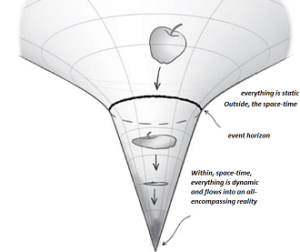
The mystery of black holes
The center of the Milky Way, the galaxy where our solar system inhabits, is formed by a disk with spiral arms and a dense, yellowish central region known as the “bulge” and there are around ten billion stars orbiting the colossal object that is its center called the supermassive black hole Sagittrius A*.
solar system inhabits, is formed by a disk with spiral arms and a dense, yellowish central region known as the “bulge” and there are around ten billion stars orbiting the colossal object that is its center called the supermassive black hole Sagittrius A*.
So, if in the past geocentrism (the Earth as the center) was a naive idea, now Heliocentrism (the sun as the center) is also a provincial and outdated idea, but what black holes are, it was not Einstein but Karl Schwarzschild who was the first to propose its existence.
Steven S. Gubser’s book “The Little Book of Black Holes”, deals in a simple way, as much as possible, explains Einstein’s special and general relativity and Schwarzschild’s equations that gave rise to the topic, black holes are one of the strong themes in current astronomy and one of the sources of research for the James Webb mega-telescope.
The book begins by recounting an experiment carried out on September 14, 2015, almost a hundred years after Einstein announced his theory of general relativity, two massive detectors, one in Louisiana and the other in Washington, were carrying out a gravitational wave experiment when they detected an audible signal, such as a serious knock and five months later they announced that they had detected two colliding black holes forming a larger one, the discovery was spectacular.
Both black holes and gravitational waves were predicted in Einstein’s Theory. In this theory, the black hole is a region of space-time (the notion of absolute time and space has already been overcome) where all nearby matter is attracted and is impossible to escape.
There is a popular saying that everything that goes up must come down, says the author, however the idea of the Schwarzschild equations is that nothing can go up, only come down and in the case of black holes where does that which must come down go, that is, what happens to what is attracted to the black hole.
We know the story of the apple that would have inspired Newton’s law of universal gravitation, the author of the book then suggests an apple falling into a black hole.
An apple outside the black hole events everything is static, at the horizon of these events everything is dynamic, flowing towards an all-encompassing singularity (where space-time changes dynamically in an extraordinary way, there two dimensions compress and the third is stretched.
Stephen Hawking, famous for proposing Big Bang equations, speculated that black holes are not actually black, they have their color (in fact, outside our visual range of colors from violet to red) determined by temperature, energy and entropy of its surface (if we can call the two dimensions that, since it is space-time).
This simplified introduction is developed over seven chapters of the book, in astronomical details and their equations, which requires some more specific knowledge of physics.
Gubser, Steven S., Pretorius, F. 2021. The Little Book of Black Hole. US: Princeton Press, 2018.









